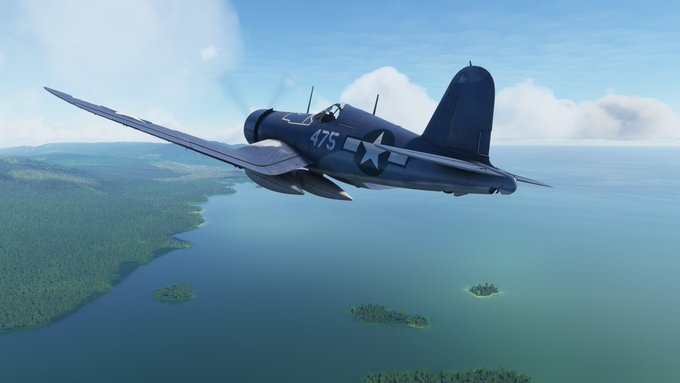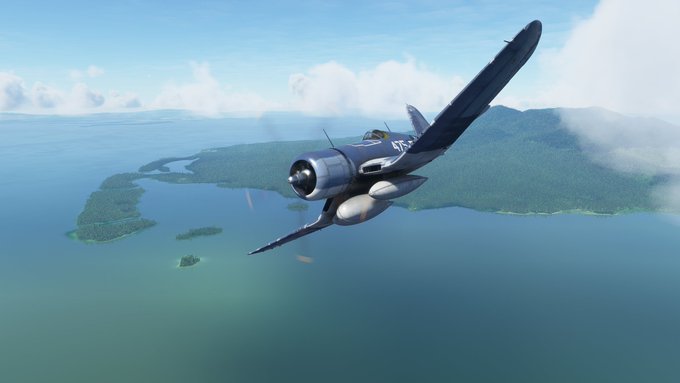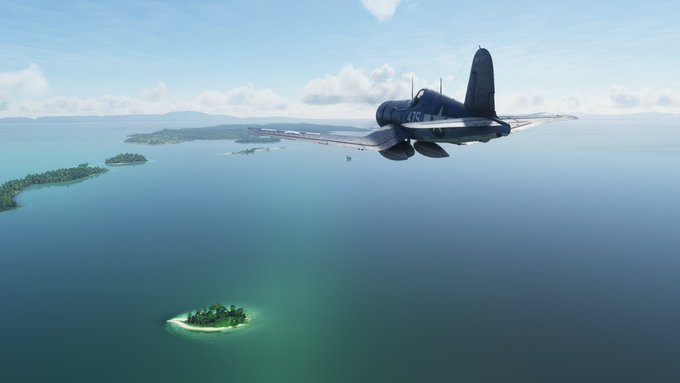December 17, 2022
Welcome to Munda, in the Solomon Islands, where I’ll be checking out the iconic the F4U-1 Corsair in its natural WW2 habitat, in Microsoft Flight Simulator.

As some of you may recall, I’ve actually been to Munda, where I did an extensive post on the World War II campaign there and at nearby Guadalcanal.

Now the reason I’ve actually chosen Munda for this flight is it was one of the first bases, in September 1943, for VMF-214, “Pappy” Boyington’s famous “Black Sheep Squadron, which flew Marine F4U-1 Corsairs. I’ll have more to say about them in a bit.

First a little about the plane itself. It was designed by Vought in 1938, in response to a US Navy request stressing the need for a very fast and powerful single-engine fighter that could land on a carrier.

To meet the speed requirement, Vought installed the largest engine it could. With a massive 18 cylinders, it produced over 2,000 horsepower, twice the P-40 I demonstrated earlier this week. Compare that to 180hp for a Cessna 172. The thing was a monster.

This presented an immediate engineering challenge. The Corsair had a propeller with a 18-foot diameter, larger than any other single-engine plane. How could such a huge propeller clear the ground without having equally tall landing gear?

The solution, of course, was the distinctive gull-shaped wings. Not only did they raise the fuselage above the height of the (now-manageable) landing gear, they also reduced the aerodynamic drag where the wing met the body of the plane.

Of course, because it would be a carrier-based plane, the wings had to fold up in order to conserve space.

They were raised and lowered using hydraulic pumps. A second set of hydraulic pumps inserted metal bolts to keep the wings in place during flight.

View of the folded wings from inside the cockpit.

Lowering the wings back in place. I’ll talk more about how this design worked out – and the problems it presented – once I take off.

Here’s the cockpit. Now technically, this is a FG-1D. That means it was manufacturing under license from Vought by Goodyear, but it’s basically identical to a F4U-1.

On the left we have (as usual for a WW2 fighter) the power controls, the trim dials, and – in this case – the wing folding levers and locks.

On the right are the various cooling flap levers, as well as the lights, radio, and other electronics.

With such a powerful single engine, taking off in a Corsair is really tricky. I do not mind telling you that the first 10 times I tried, the plane basically tried to flip over on me, like this, and I had to cut power and abort.

The key is setting the rudder AND aileron trip 6 degrees to the right, each, AND THEN adding strong right rudder of your own BEFORE the plane gains speed and makes a sudden lunge to the left. Note the rudder position.

When it lurches left, you have to kick hard right rudder AND pull the stick LEFT (in the turn) to prevent it from tipping over the right. If you overcorrect, you have to do the opposite. Even as you take off, the wings will dip alarmingly and you have to adjust using the stick.

But hey, I finally figured it out.

I actually found that you keep the rightward trim settings in the entire time, just to keep the plane stable.

By the time the F4U was approved, in 1942, it was clear from the war in Europe that bigger machine guns would be needed. To make room for them, fuel tanks were removed and placed under the fuselage – where there was space because of the drooping gull wing.

Before I say anything more, I’m just going to mention that the little oblong-shaped island right below me, as I make my initial turn back to the northwest, was John F. Kennedy’s PT-boat base in World War II.

Here’s a photo I took flying over it in real life:

And here’s me paying a visit there, by boat:

Here it is again, just in front of my nose. Sadly, MSFS hasn’t modeled the coral reefs here, though they have in other places of the world. Hopefully they will.

So Voight produced a really powerful and really fast fighter, the first US fighter plane capable of over 400 miles per hour (I’m only going about 210 knots here).

The problem was, the huge engine put the pilot back too far, making it hard to see over the nose for a carrier landing.

The Corsair also tended to bounce on landing, which was not good for carrier landings.

So the Navy decided to go with the F6F Hellcat, which while not as powerful, was more reliable on carrier landings, and initially assigned the F4U Corsair to land-based Marine squadrons in the South Pacific – like VMF-214 here at Munda.

Quick aside: one of these small islands here in Vonavona Lagoon, either above or below my right wing, is Skull Island, a sacred burial place for local headhunter chiefs and the skulls of their victims.

You can check out my visit there here:

I’m flying to the northwest over Vonavona Lagoon, in the direction the Black Sheep Squadron would have flown in September 1943, escorting B-24 bombers to attack Japanese bases on islands to the northwest, where they retreated after abandoning Guadalcanal.

The large volcanic peak ahead is Kolombangara Island, which the Japanese still held at the time.

Just as in the sim, it tends to be shrouded in clouds in real life:

#475, seen here making its way over the Kula Gulf, was a real Corsair with the Black Sheep Squadron. It was flown by John F. Bolt.

Bolt initially flew out of Munda in September 1943, and survived the war as an ace with 6 confirmed kills (all Japanese Zeros in the South Pacific).

He then went on to fly F-86 Sabre fighter jets in the Korean War, shooting down 6 MiG-15s to become the only US Marine pilot to become an ace in two wars. He died in 2004, at the age of 83.

The Black Sheep Squadron’s commander, Gregory “Pappy” Boyington, was his own sort of legend.

Boyington had previously flown in the “Flying Tigers” in China, a unit (and plane) I covered in a previous thread here:

So Boyington was an experienced combat veteran. But he also had a bad reputation in the Flying Tigers for getting drunk and brawling, so when the US entered the war, he had a hard time getting a regular assignment.

When given the chance in the South Pacific, though, he proved a capable and daring commander. Since he was 31, a full decade older than most his men, they dubbed him “Pappy”.

And in keeping with his reputation, they called themselves Boyington’s Bastards, which was sanitized for the public as the “Black Sheep Squadron”.

Now another quick aside: the strait, between Kolombangara (right) and Gizo (left) is where John F. Kennedy’s PT-109 was rammed and sunk in the night by a Japanese destroyer, in August 1943, a month before the Black Sheep arrived at Munda.

And tiny Plum Pudding Island, just below me, is where Kennedy and his injured crew struggling ashore and were stranded, after swimming throughout the night. They were located and rescued a few days later.

Just north of it is the airstrip at Gizo, which US forces later constructed by filling in the gap between two existing islands. It’s still in use today, and I’ll be coming back to land here.

Just up ahead, past Gizo to the north, is Vella Lavella Island, where the Black Sheep Squadron relocated in late 1943, in order to conduct missions against major Japanese bases further north, such as Bougainville and Rabaul.

Vella Lavella sounds like an Italian movie star, but conditions there were very rough. The airstrip was basically just a sand and coral clearing next to the shore.

That green clearing below, with a coastal road running through it, is where Barakoma Airfield was located. There is nothing there now, though it does show up on my ForeFlight as an active field.

Operating out of Vella Lavella, Boyington personally shot down 26 enemy planes, tying the record set by Eddie Rickenbacker in World War I.

But the same day he matched that record, he didn’t come back from the mission, and was presumed shot down and killed.

Then in August 1945, when the war ended, a US plane flying over a Japanese POW camp spotted a surprising message on the roof of one of the barracks: “Pappy Boyington here”

Boyington returned to personally receive the Medal of Honor he had already be awarded, post mortem, from President Truman.

The Black Sheep and other Marine squadrons had successfully proven the combat effectiveness of the F4U Corsair, and the Navy went on to finally adopt it as a carrier-based plane. It ended the war with a kill ratio of 11:1. Some argue it was the best US fighter plane of the war.

More advanced versions of the F4U went on to fight, mainly in a ground support role, in the Korean War, until the MiG-15 jet fighter rendered it obsolete. It was the last US piston-driven fighter plane.

I have been warned that landing the F4U Corsair can be as tricky as taking off, so here goes. That’s the airstrip at Gizo ahead.

I’ve slowed down to 140 knots and lowered my gear and 20% flaps. I can already tell it needs to fly with the nose higher at this speed.

Trying to do an actual downwind pattern here at 1,000 feet, with Gizo to my left.

One of the problems the Corsair had is, the gull wings had a higher stall speed than desired. And when you make a steep turn, the load factor on the wings raises the stall speed. As I turn to base, I can feel it buffeting like it wants to stall, forcing me to keep the nose down.

Gizo’s runway is 2,800 feet, the same as the (relatively short) one I land on in real life with my Cessna 172. But with the Corsair, I have to come in almost twice as fast. My approach speed (65 knots) in a Cessna is already below the stall speed of a Corsair with full flaps.

It was bumpy, and a little scary, and I really had to pump the brakes to slow but not tip over. And I ended up using almost all of the runway to stop.

But hey, I made it. (I don’t know how Solomon Airlines does it, but they do).

I hope you enjoyed yet another peek at an interesting aircraft and its history. And do visit the Solomon Islands. It’s a long haul, and not exactly easy to get around, but it’s worth it.

[…] did a separate post on flying the gull-winged Corsair, where I talk about the same issue and why the otherwise fast and powerful F4U got relegated to the […]